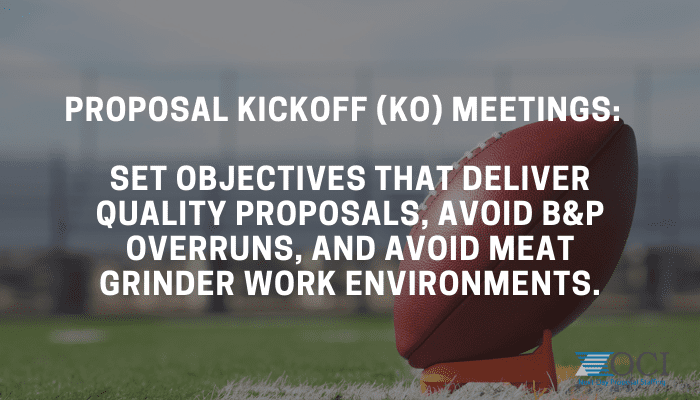Proposal Kickoff (KO) Meetings – set objectives that deliver quality proposals, avoid B&P overruns, and avoid meat grinder work environments.
This means formally transitioning from your Capture/Program Operations activity to your Proposal activity through a clearly defined and delivered KO meeting, where the end result should be a cohesive team, following a detailed plan forward, delivered on schedule and on budget.
If you rolled your eyes at any of that because your B&P limitations have created KO group gropes that do not prevent proposal pain and chaos – then you might be a proposal victim, and this article could benefit your organization.
Do your own thing with the information presented here. What works for you is what best fits your culture and capabilities.
Pre-Planning
Pre-Planning should include the development of the KO checklist covering the moving parts of the KO meeting, such as:
- Defining all the who, what, when, where, and how of the KO (think WBS/IMP/IMS)
- Incorporation of lessons learned from previous KO meetings and their proposals
- A KO meeting agenda built like an orals presentation with presenters, topic list and time allocation
- Invitee list that includes the usual direct and indirect victims as well as the Pink and Red Team members
- A plan to develop and review presentation materials to eliminate redundancy and ambiguity; and that:
- Identifies the hard/soft copy read-ahead and day-of-meeting materials requirements lists/quantities as necessary; and
- Identifies the support items and people needed to carry out the KO.
The Proposal Kickoff Meeting
For all KO meetings – it is important that they start on time and stay on agenda/schedule. You have pulled a boatload of people away from their day jobs and probably gave them the B&P charge number. Try not to waste their time. And, there’s a good possibility that some attendees are only there for the free food or for time away from their desks. You should take charge and effectively manage all of them.
In typical Proposal Kickoff meetings, objective-driven content includes:
- Team building and motivation introduction that includes direct evidence of Executive Commitment to the bid
- Bid opportunity and Program overviews
- A summary of the win strategy and themes that includes customer insights, competitor strengths to beat and weaknesses to exploit
- Solicitation overview including SOW/PWS, Sections L, M, list of deliverables, unique/challenging requirements hidden within the DD254, Sample Tasks, or Section H
- Your solutions for Tech Approach, Program Plan, Risk Plan, Staffing/Transition Plan, Quality Plan, etc., including a list of Teammates and their roles and responsibilities, a draft WBS and Program organization chart with labor distribution, SB approach, Corporate Experience and Past Performance citations
- Proposal Management Plan and Approach including a draft calendar/schedule and milestones, integrated proposal outline/compliance matrix, Proposal Organization Chart with Roles and Responsibilities, proposal tempo of operation/ meetings schedule, proposal content (art and text) development processes and tools, facilities plan, proposal security, templates, proposal version control, communications and security, proposal production support and how to use it
- Proposal Reviews approach, methods and deliverables
- Support materials and administrivia including charge number, Team contact list, action items management and review
- Next Steps necessary to focus and motivate the Team
- Around the room and on the phone last call, followed by meeting closure, which includes executive/leadership acknowledgment of contributor sacrifices.
KO Meeting Measures of Effectiveness (MOE)
MOE or its siblings Measures of Performance (MOP) and Measures of Suitability (MOS) provide comparisons of how well the KO meeting achieved its objectives. Typical objectives were listed above in Typical KO meetings, objective-driven content subsection. The MOE high level scope includes, did you identify the right things (suitability to your BD environment)? And how well did you do them (Performance) as identified by feedback from the proposal team. Formally tracking those measures provides you with lessons learned to improve future KO meetings.
High Risk Things to avoid in Proposal Kickoff Meetings include:
- Failure to ask for comments and questions during the KO
- Allowing the “smart people” who created the win strategy and Program approaches to dump-and-run after the KO
- Failure to be realistic about the B&P necessary to create and deliver a winning proposal
- Adding new “good idea fairies” at the Color Teams
- Leaving the Capture and Program planning up to the proposal team, to “save B&P” (or Capture dollars)
A quick brainstorming session should generate a starting point for a B&P scars list that is specific to your experience on previous proposal efforts.
Reaching and Exceeding your Goals
For help with any proposal task between kickoff and win, please reach out below!






Leave A Comment